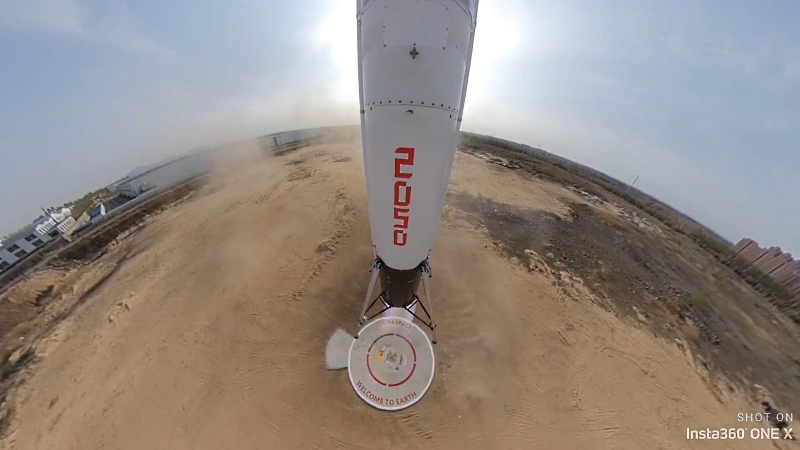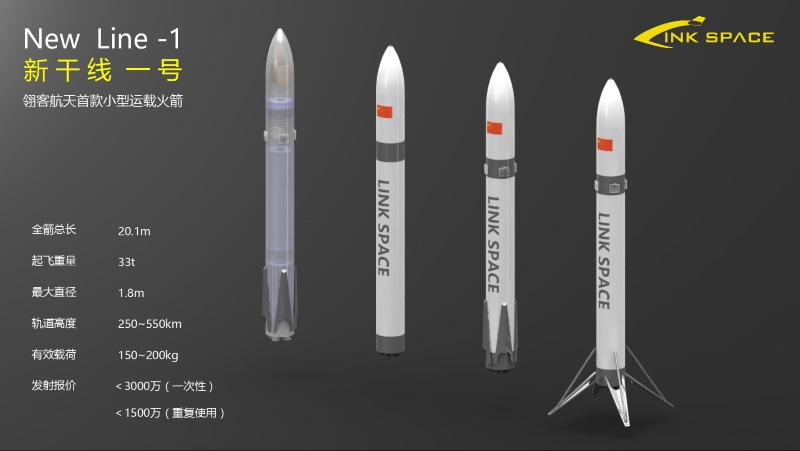Jumping Chinese Grasshopper by LinkSpace
LinkSpace, a Chinese private space company, has built a vertical takeoff and landing test rocket booth similar to SpaceX's Grasshopper, and has been conducting increasingly complex tests since January this year. After hanging tests on a leash, the company switched to full-fledged jumps, rising by 20 meters on March 27, and by 40 meters on April 19. And thanks to progress in action cameras, we can look at these flights from the angles that were absent during the Grasshopper Mask.

A shot from the video of the onboard camera
LinkSpace, a Chinese private space company, was founded in 2014. In 2017, they fell into the space news feeds, introducing the NewLine-1 rocket project using SpaceX's ideas - a vertical landing of the first stage on engines.

Slide sensational presentation
Visually, the first step looked exactly like the Falcon 9, including trellised rudders, folding supports and even coloring, which generated a lot of comments about copying SpaceX technologies. In fact, NewLine-1 will be much smaller, they plan to install a different number of engines with less traction on it, and it is more correct to say that LinkSpace was inspired by the SpaceX concept and implement the same method of providing reusability, but on their technologies.
In 2016-18, the company tested the flying stand, which was a frame with tanks even without external casing. As in any complex technique, there were setbacks, but by the beginning of 18, the stand had learned to rise and sit back without a leash.
Unsuccessful test or why start with leash tests:

One of the last tests, beginning of 2018.
For any serious flights, the first stand was small, so LinkSpace made a larger model RLV-T5, also called NewLine Baby. The new test bench has five engines, a height of 8.1 meters and a mass of 1.5 tons. At the beginning of the year, leash tests started, which, judging by the timing of the transition to the next stage, were successful.
On March 27, the device first went on an independent flight, rose to a height of 20 meters and made a soft landing at the launch site.
And on April 19, NewLine Baby successfully flew up to 40 meters. In addition to the already familiar shooting from the drone, there was a 360 ° camera on the rocket, which made it possible to see the flight from an unusual angle.

Video in the best quality and with music from the link
The camera mounts cannot be distinguished on the video, but it should be so. Modern 360 ° cameras are able to cut mounts (or selfie sticks) when processing captured frames and create the complete illusion that the camera is flying next to the rocket.
The announced plans for LinkSpace to storm an altitude of 1 km, followed by a soft landing in the second half of this year. This is comparable to the SpaceX trial of the Grasshopper, the first version of which climbed to 744 meters, and the second to kilometer. The first flight of a full-fledged NewLine-1 orbital rocket is planned for 2021. It is expected that the rocket will be able to put 200 kg into low Earth orbit, and the launch cost in LinkSpace was called equal to $ 4.6 million for a new rocket and 2.3 million for a reused one. In 2017, only six people worked at LinkSpace, now 20.

A shot from the video of the onboard camera
LinkSpace, a Chinese private space company, was founded in 2014. In 2017, they fell into the space news feeds, introducing the NewLine-1 rocket project using SpaceX's ideas - a vertical landing of the first stage on engines.

Slide sensational presentation
Visually, the first step looked exactly like the Falcon 9, including trellised rudders, folding supports and even coloring, which generated a lot of comments about copying SpaceX technologies. In fact, NewLine-1 will be much smaller, they plan to install a different number of engines with less traction on it, and it is more correct to say that LinkSpace was inspired by the SpaceX concept and implement the same method of providing reusability, but on their technologies.
In 2016-18, the company tested the flying stand, which was a frame with tanks even without external casing. As in any complex technique, there were setbacks, but by the beginning of 18, the stand had learned to rise and sit back without a leash.
Unsuccessful test or why start with leash tests:

One of the last tests, beginning of 2018.
For any serious flights, the first stand was small, so LinkSpace made a larger model RLV-T5, also called NewLine Baby. The new test bench has five engines, a height of 8.1 meters and a mass of 1.5 tons. At the beginning of the year, leash tests started, which, judging by the timing of the transition to the next stage, were successful.
On March 27, the device first went on an independent flight, rose to a height of 20 meters and made a soft landing at the launch site.
And on April 19, NewLine Baby successfully flew up to 40 meters. In addition to the already familiar shooting from the drone, there was a 360 ° camera on the rocket, which made it possible to see the flight from an unusual angle.

Video in the best quality and with music from the link
The camera mounts cannot be distinguished on the video, but it should be so. Modern 360 ° cameras are able to cut mounts (or selfie sticks) when processing captured frames and create the complete illusion that the camera is flying next to the rocket.
The announced plans for LinkSpace to storm an altitude of 1 km, followed by a soft landing in the second half of this year. This is comparable to the SpaceX trial of the Grasshopper, the first version of which climbed to 744 meters, and the second to kilometer. The first flight of a full-fledged NewLine-1 orbital rocket is planned for 2021. It is expected that the rocket will be able to put 200 kg into low Earth orbit, and the launch cost in LinkSpace was called equal to $ 4.6 million for a new rocket and 2.3 million for a reused one. In 2017, only six people worked at LinkSpace, now 20.
